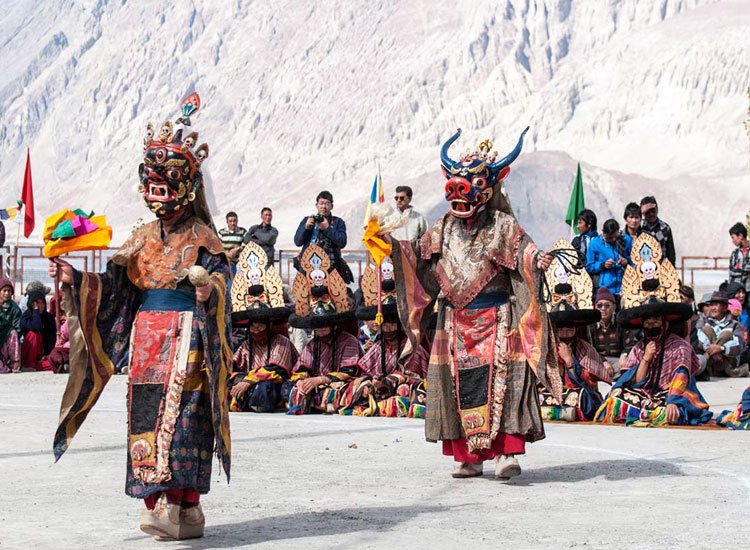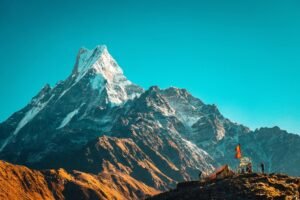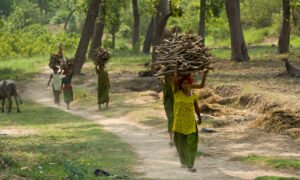The Himalayan region, stretching across five countries—India, Nepal, Bhutan, China, and Pakistan—is not only renowned for its breathtaking landscapes but also for its rich cultural heritage. The region’s festivals and traditions are a vibrant tapestry woven from its diverse ethnic communities, religious practices, and historical influences. This article explores some of the most famous festivals and traditions of the Himalayan region, highlighting their significance, unique customs, and the cultural ethos they represent.
Festivals in India’s Himalayan Region
Losar (Tibetan New Year)
Losar, the Tibetan New Year, is one of the most significant festivals celebrated in the Himalayan regions of India, particularly in Ladakh, Himachal Pradesh, and Sikkim. It marks the beginning of the Tibetan lunar calendar and is celebrated with great fervor and enthusiasm.
Customs and Celebrations:
Preparation: Preparations for Losar begin weeks in advance. Houses are cleaned and decorated, new clothes are bought, and special dishes like ‘guthuk’ (a noodle soup) are prepared.
Chanting and Prayers: Monasteries are the focal point of celebrations. People visit monasteries to offer prayers and participate in religious ceremonies. Monks chant mantras and perform traditional dances called ‘Cham’ to drive away evil spirits.
Festive Activities: The festival lasts for several days, featuring traditional music, dance, and sports. People exchange gifts, visit friends and family, and participate in feasts.
Hemis Festival
The Hemis Festival is a two-day celebration held at Hemis Monastery in Ladakh, India. It commemorates the birth of Guru Padmasambhava, the founder of Tibetan Buddhism.
Customs and Celebrations:
Cham Dance: The highlight of the festival is the Cham dance, performed by monks wearing elaborate masks and costumes. The dance depicts the victory of good over evil and is accompanied by traditional music.
Religious Displays: Sacred thangkas (Buddhist scroll paintings) are unfurled, and various religious rituals are performed.
Market Stalls: Local artisans set up stalls around the monastery, selling handicrafts, jewelry, and local cuisine, adding to the festive atmosphere.
Baisakhi
Baisakhi, primarily a harvest festival, holds great importance in the state of Himachal Pradesh. It marks the beginning of the harvest season and is also celebrated as the Punjabi New Year.
Customs and Celebrations:
Fairs and Processions: Villages and towns host vibrant fairs, where people gather to enjoy traditional music, dance, and food. Processions with folk dancers and drummers are common.
Rituals: People take ritual baths in rivers and visit temples to offer prayers. The Gurudwaras (Sikh temples) hold special services and community feasts known as ‘Langar.’
Dances: Traditional dances like Bhangra and Gidda are performed, showcasing the cultural heritage of the region.
Festivals in Nepal
Dashain
Dashain is the longest and most auspicious festival in Nepal, celebrated by Nepalese people of all castes and creeds throughout the country. It symbolizes the victory of good over evil.
Customs and Celebrations:
Tika and Jamara: On the main day, family members receive ‘Tika’ (a mixture of yogurt, rice, and vermilion) and ‘Jamara’ (barley grass) from elders, symbolizing blessings for prosperity and long life.
Animal Sacrifices: In many parts of Nepal, animal sacrifices are performed to honor the goddess Durga, believed to have triumphed over the demon Mahishasura.
Feasts and Gatherings: Families reunite and celebrate with grand feasts, where traditional foods like goat meat, rice, and various sweets are prepared.
Tihar
Tihar, also known as Deepawali, is the second most significant festival in Nepal. It spans five days and honors various animals that play a crucial role in human lives.
Customs and Celebrations:
Day 1 – Kag Tihar: Crows, considered messengers of death, are worshipped by offering them food.
Day 2 – Kukur Tihar: Dogs are celebrated and adorned with garlands, tika, and delicious food for their loyalty and protection.
Day 3 – Gai Tihar and Laxmi Puja: Cows are worshipped in the morning, and in the evening, houses are lit with oil lamps to welcome Goddess Laxmi, the deity of wealth.
Day 4 – Govardhan Puja: Oxen are worshipped and honored for their role in agriculture.
Day 5 – Bhai Tika: Sisters pray for their brothers’ long life and prosperity, applying tika on their foreheads and performing a special ceremony.
Holi
Holi, the festival of colors, is celebrated with great joy and enthusiasm across Nepal. It signifies the arrival of spring and the triumph of good over evil.
Customs and Celebrations:
Color Play: People smear each other with colors, dance, and sing. Water balloons and water guns are also used to add to the fun.
Traditional Music: Traditional songs and dances are performed, and people visit friends and family to exchange sweets and greetings.
Bonfires: On the eve of Holi, bonfires are lit to symbolize the burning of the demoness Holika, representing the victory of good over evil.
Festivals in Bhutan
Tshechu
Tshechu is a religious festival held annually in each district of Bhutan. It honors Guru Rinpoche, who introduced Tantric Buddhism to Bhutan.
Customs and Celebrations:
Mask Dances: The main attraction is the series of Cham dances performed by monks in elaborate costumes and masks. Each dance has a specific meaning and is believed to bring blessings and protection to the spectators.
Religious Blessings: Attending a Tshechu is considered an act of faith and devotion, believed to cleanse one’s sins and bring good fortune.
Social Gathering: Tshechus are also a time for socializing, with people dressed in their finest traditional attire, enjoying festive foods, and participating in community activities.
Thimphu Drubchen
Thimphu Drubchen is a unique Bhutanese festival that commemorates the victory of Bhutanese forces over Tibetan invaders in the 17th century.
Customs and Celebrations:
Dance Performances: The festival features sacred masked dances performed by monks, symbolizing the protection of the country by deities.
Historical Reenactments: Drubchen also includes reenactments of historical events, showcasing the bravery and valor of Bhutanese warriors.
Cultural Displays: The festival provides a platform for showcasing Bhutanese culture through traditional music, dance, and crafts.
Festivals in Tibet (China)
Losar (Tibetan New Year)
Losar, the Tibetan New Year, is celebrated with great enthusiasm in Tibet. It is similar to the Losar celebrated in the Indian Himalayan regions but with unique Tibetan customs.
Customs and Celebrations:
House Cleaning and Decorations: Homes are thoroughly cleaned and decorated with auspicious symbols and colorful flags. Offerings are made to deities and ancestors.
Rituals and Ceremonies: Monasteries hold special ceremonies, including prayers, dances, and the making of mandalas. Monks perform traditional Cham dances to ward off evil spirits.
Feasting and Family Gatherings: Families gather to prepare and enjoy special dishes like ‘Guthuk’ (a noodle soup) and ‘Kapse’ (fried pastries). Gifts are exchanged, and people visit friends and relatives.
Shoton Festival
The Shoton Festival, also known as the Yogurt Festival, is one of the most popular festivals in Tibet. It marks the end of the monks’ meditation retreat and the beginning of summer.
Customs and Celebrations:
Thangka Unveiling: The festival begins with the unveiling of a giant thangka (Buddhist scroll painting) at Drepung Monastery, attracting thousands of pilgrims.
Opera Performances: Tibetan opera troupes perform traditional operas in Norbulingka Palace. These performances depict religious and historical stories.
Yogurt Feast: The festival is named after the tradition of offering yogurt to monks who have completed their meditation retreat. This custom continues with families sharing yogurt among themselves.
Festivals in Pakistan’s Gilgit-Baltistan
Navroz (Nowruz)
Navroz, also known as Nowruz, is the Persian New Year celebrated with enthusiasm in the Gilgit-Baltistan region of Pakistan. It marks the arrival of spring and is a symbol of renewal and rejuvenation.
Customs and Celebrations:
Spring Cleaning: Homes are cleaned and decorated with flowers and colorful items to welcome the new year.
Traditional Music and Dance:The celebrations feature traditional music and dance performances, including the famous ‘Bofaw,’ a dance performed with colorful scarves.
Feasting: Special dishes are prepared, and families come together to enjoy meals and celebrate the beginning of a new year.
Jashn-e-Baharan
Jashn-e-Baharan, meaning “Spring Festival,” is a vibrant celebration of the arrival of spring in the Gilgit-Baltistan region. It is characterized by cultural events and community gatherings.
Customs and Celebrations:
Flower Shows: The festival features flower shows where various species of spring flowers are displayed, symbolizing the beauty and renewal of nature.
Cultural Performances:** Traditional music, dance, and poetry recitations are an integral part of the celebrations. Local artists showcase their talents, preserving and promoting the region’s cultural heritage.
Sports and Competitions: Various sports competitions, such as polo matches and tug-of-war, are held, adding to the festive spirit.
Unique Traditions of the Himalayan Region
Mani Rimdu (Nepal and Tibet)
Mani Rimdu is a sacred festival celebrated in the Solu-Khumbu region of Nepal and Tibet. It honors the founding of Buddhism by Guru Rinpoche.
Customs and Celebrations:
Rituals and Prayers: The festival involves a series of elaborate rituals, including prayers, the construction of sand mandalas, and the blessing of the people by monks.
Masked Dances: Monks perform masked dances representing deities, demons, and animals, symbolizing the triumph of Buddhism over evil.
Community Feast: The festival concludes with a community feast, where villagers come together to share food and celebrate.
Muktinath Yatra (Nepal)
Muktinath Yatra is a pilgrimage to the Muktinath Temple, located in the Mustang district of Nepal. The temple is sacred to both Hindus and Buddhists.
Customs and Celebrations:
Pilgrimage: Devotees undertake a challenging journey to reach the temple, believed to cleanse sins and grant salvation. The trek itself is considered a form of penance.
Ritual Bathing: Pilgrims take ritual baths in the 108 waterspouts and two holy ponds at the temple, which are believed to purify the soul.
Offerings:** Offerings of flowers, fruits, and incense are made to the deities, and special prayers are conducted by priests.
Butter Sculpture Festival (Tibet)
The Butter Sculpture Festival, known as ‘Chunga Choepa,’ is celebrated in Tibet during the Tibetan New Year. It showcases intricate sculptures made from butter.
Customs and Celebrations:
Butter Sculptures: Monks create elaborate butter sculptures depicting religious and mythological themes. These sculptures are displayed in monasteries and attract many visitors.
Candles and Lamps: Butter lamps are lit in large numbers, symbolizing the victory of light over darkness and ignorance.
Prayers and Rituals: Monks chant prayers and conduct rituals, seeking blessings for prosperity and good fortune in the coming year.
The festivals and traditions of the Himalayan region are a reflection of its rich cultural diversity and spiritual heritage. These celebrations, deeply rooted in religious beliefs and historical practices, bring communities together, foster a sense of identity, and provide a means to preserve and transmit cultural values to future generations.
From the vibrant Losar celebrations in Tibet and the Hemis Festival in Ladakh to the deeply spiritual Dashain and Tihar in Nepal, each festival is unique in its customs and significance. The shared traditions, such as the Cham dances, mask dances, and the lighting of butter lamps, highlight the interconnectedness of the Himalayan cultures despite their geographical separation.
As the region continues to face the challenges of modernization and climate change, these festivals and traditions serve as a vital link to the past, offering resilience and continuity to the Himalayan way of life. Embracing and celebrating this cultural heritage is essential for sustaining the vibrant and diverse identity of the Himalayan peoples.





